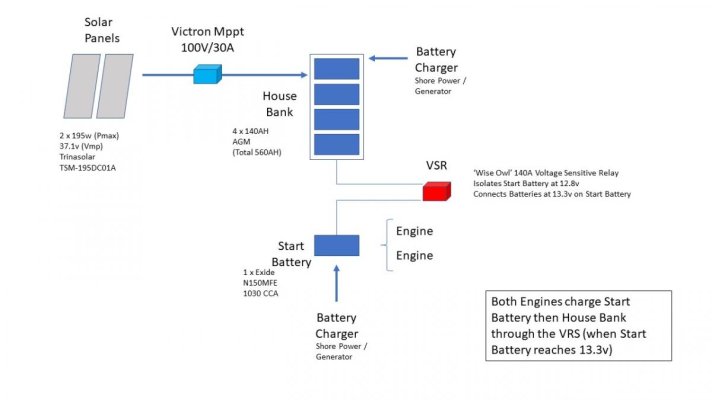SteveJ
Member
Hi all, appreciate any views on the way the batteries have been configured on our boat: we've had it for less than two years so we've inherited the configuration. The boat is a CheoyLee 34' trawler (mid 1980s) with twin Ford Lees 120hp deisels. I have just replaced both the house bank (4x140AH AGM batteries) and the start battery (1x1030 CCA). This is a 'like for like' replacement for what was installed and was driven by the age of the batteries, measured and observed average performance from both banks and lack of knowledge of their lineage and history. The new batteries have been in a month and are working very well in comparison. My question relates to to the way they have been configured with a voltage sensitive relay. My understanding is that both engines charge the start battery, which upon reaching 13.3V closes a circuit through the VSR and allows the engines to push charge into the house bank. Both banks remain connected until the start battery reads 12.8V when the VSR opens and isolates the start battery. Which makes sense to me - keeping your start battery fully charged even if your house bank is discharged. With solar panels charging the house bank, it is usual for the battery banks to be connected. So... when it comes to starting the engines should I be concerned to do so if the banks are connected? I have a large capacity (1030 cold cranking amp) start battery - should I isolate this from the deep cycle AGMs (which I can do) or is it ok to leave the two banks (and two different types of batteries) connected when I start up? I've included a diagram of the setup. Thanks in advance for any advice.
Regards, Steve
Regards, Steve


 Especially with a single engine as I have, There is a manual parallel switch in my set up with full start current capacity between house and start. Had to use it once when boat was at a pier with no power for a few days and the old start batteries showed their weakness.
Especially with a single engine as I have, There is a manual parallel switch in my set up with full start current capacity between house and start. Had to use it once when boat was at a pier with no power for a few days and the old start batteries showed their weakness.